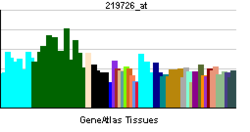- NLGN3
-
Neuroligin 3 Identifiers Symbols NLGN3; HNL3; KIAA1480 External IDs OMIM: 300336 MGI: 2444609 HomoloGene: 23133 GeneCards: NLGN3 Gene Gene Ontology Molecular function • carboxylesterase activity
• receptor activity
• protein bindingCellular component • cytoplasm
• integral to plasma membrane
• cell surface
• membrane
• endocytic vesicle
• synapseBiological process • receptor-mediated endocytosis
• cell adhesion
• neuron cell-cell adhesion
• synapse assembly
• social behavior
• regulation of synaptic transmission
• synapse organization
• positive regulation of synaptogenesisSources: Amigo / QuickGO RNA expression pattern 
More reference expression data Orthologs Species Human Mouse Entrez 54413 245537 Ensembl ENSG00000196338 ENSMUSG00000031302 UniProt Q9NZ94 Q69ZI4 RefSeq (mRNA) NM_001166660.1 NM_172932.3 RefSeq (protein) NP_001160132.1 NP_766520.2 Location (UCSC) Chr X:
70.36 – 70.39 MbChr X:
98.49 – 98.52 MbPubMed search [1] [2] Neuroligin-3 is a protein that in humans is encoded by the NLGN3 gene.[1][2][3]
This gene encodes a member of the neuroligin family of neuronal cell surface proteins. Neuroligins may act as splice site-specific ligands for beta-neurexins and may be involved in the formation and remodeling of central nervous system synapses. Mutations in this gene may be associated with autism and Asperger syndrome. Multiple transcript variants encoding distinct isoforms have been identified for this gene, but their full length sequences have not been determined.[3]
References
- ^ Philibert RA, Winfield SL, Sandhu HK, Martin BM, Ginns EI (May 2000). "The structure and expression of the human neuroligin-3 gene". Gene 246 (1–2): 303–10. doi:10.1016/S0378-1119(00)00049-4. PMID 10767552.
- ^ Nagase T, Kikuno R, Ishikawa K, Hirosawa M, Ohara O (Sep 2000). "Prediction of the coding sequences of unidentified human genes. XVII. The complete sequences of 100 new cDNA clones from brain which code for large proteins in vitro". DNA Res 7 (2): 143–50. doi:10.1093/dnares/7.2.143. PMID 10819331.
- ^ a b "Entrez Gene: NLGN3 neuroligin 3". http://www.ncbi.nlm.nih.gov/sites/entrez?Db=gene&Cmd=ShowDetailView&TermToSearch=54413.
Further reading
- Missler M, Fernandez-Chacon R, Südhof TC (1998). "The making of neurexins". J. Neurochem. 71 (4): 1339–47. doi:10.1046/j.1471-4159.1998.71041339.x. PMID 9751164.
- Cantallops I, Cline HT (2000). "Synapse formation: if it looks like a duck and quacks like a duck ...". Curr. Biol. 10 (17): R620–3. doi:10.1016/S0960-9822(00)00663-1. PMID 10996085.
- Ichtchenko K, Nguyen T, Südhof TC (1996). "Structures, alternative splicing, and neurexin binding of multiple neuroligins". J. Biol. Chem. 271 (5): 2676–82. doi:10.1074/jbc.271.5.2676. PMID 8576240.
- Irie M, Hata Y, Takeuchi M, et al. (1997). "Binding of neuroligins to PSD-95". Science 277 (5331): 1511–5. doi:10.1126/science.277.5331.1511. PMID 9278515.
- Nguyen T, Südhof TC (1997). "Binding properties of neuroligin 1 and neurexin 1beta reveal function as heterophilic cell adhesion molecules". J. Biol. Chem. 272 (41): 26032–9. doi:10.1074/jbc.272.41.26032. PMID 9325340.
- Gilbert M, Smith J, Roskams AJ, Auld VJ (2001). "Neuroligin 3 is a vertebrate gliotactin expressed in the olfactory ensheathing glia, a growth-promoting class of macroglia". Glia 34 (3): 151–64. doi:10.1002/glia.1050. PMID 11329178.
- Strausberg RL, Feingold EA, Grouse LH, et al. (2003). "Generation and initial analysis of more than 15,000 full-length human and mouse cDNA sequences". Proc. Natl. Acad. Sci. U.S.A. 99 (26): 16899–903. doi:10.1073/pnas.242603899. PMC 139241. PMID 12477932. http://www.pubmedcentral.nih.gov/articlerender.fcgi?tool=pmcentrez&artid=139241.
- Jamain S, Quach H, Betancur C, et al. (2003). "Mutations of the X-linked genes encoding neuroligins NLGN3 and NLGN4 are associated with autism". Nat. Genet. 34 (1): 27–9. doi:10.1038/ng1136. PMC 1925054. PMID 12669065. http://www.pubmedcentral.nih.gov/articlerender.fcgi?tool=pmcentrez&artid=1925054.
- Ota T, Suzuki Y, Nishikawa T, et al. (2004). "Complete sequencing and characterization of 21,243 full-length human cDNAs". Nat. Genet. 36 (1): 40–5. doi:10.1038/ng1285. PMID 14702039.
- Vincent JB, Kolozsvari D, Roberts WS, et al. (2005). "Mutation screening of X-chromosomal neuroligin genes: no mutations in 196 autism probands". Am. J. Med. Genet. B Neuropsychiatr. Genet. 129 (1): 82–4. doi:10.1002/ajmg.b.30069. PMID 15274046.
- Gauthier J, Bonnel A, St-Onge J, et al. (2005). "NLGN3/NLGN4 gene mutations are not responsible for autism in the Quebec population". Am. J. Med. Genet. B Neuropsychiatr. Genet. 132 (1): 74–5. doi:10.1002/ajmg.b.30066. PMID 15389766.
- Yan J, Oliveira G, Coutinho A, et al. (2005). "Analysis of the neuroligin 3 and 4 genes in autism and other neuropsychiatric patients". Mol. Psychiatry 10 (4): 329–32. doi:10.1038/sj.mp.4001629. PMID 15622415.
- Otsuki T, Ota T, Nishikawa T, et al. (2007). "Signal sequence and keyword trap in silico for selection of full-length human cDNAs encoding secretion or membrane proteins from oligo-capped cDNA libraries". DNA Res. 12 (2): 117–26. doi:10.1093/dnares/12.2.117. PMID 16303743.
- Blasi F, Bacchelli E, Pesaresi G, et al. (2006). "Absence of coding mutations in the X-linked genes neuroligin 3 and neuroligin 4 in individuals with autism from the IMGSAC collection". Am. J. Med. Genet. B Neuropsychiatr. Genet. 141 (3): 220–1. doi:10.1002/ajmg.b.30287. PMID 16508939.
- Talebizadeh Z, Lam DY, Theodoro MF, et al. (2006). "Novel splice isoforms for NLGN3 and NLGN4 with possible implications in autism". J. Med. Genet. 43 (5): e21. doi:10.1136/jmg.2005.036897. PMC 2564526. PMID 16648374. http://www.pubmedcentral.nih.gov/articlerender.fcgi?tool=pmcentrez&artid=2564526.
- Yamakawa H, Oyama S, Mitsuhashi H, et al. (2007). "Neuroligins 3 and 4X interact with syntrophin-gamma2, and the interactions are affected by autism-related mutations". Biochem. Biophys. Res. Commun. 355 (1): 41–6. doi:10.1016/j.bbrc.2007.01.127. PMID 17292328.
Categories:- Human proteins
- Chromosome X gene stubs
Wikimedia Foundation. 2010.
